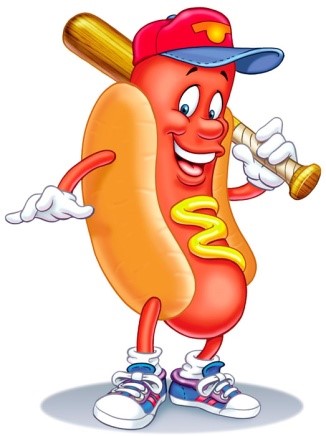Baseball & Hot Dogs

Most baseball history books skip the contributions made by caterers, vendors, and concessionaires who worked hard to feed hungry fans. Presumably, the foods consumed by the earliest baseball fans in the late 19th century were similar to those available in outdoor/sporting venues. Foods served at late 19th century American fairs, race tracks, circuses, railroad stops, and such tended to be portable and simple. These included sandwiches, peanuts, ice cream, soft drinks, beer, cotton candy, and yes, the ubiquitous hot dog.
Foods sold in baseball stadiums vary according to local place and taste. The menu selections at Fenway and Yankee Stadium are understandably different. Chowder in Fenway; hot pretzels (with mustard) in Philadelphia; Nathan's Famous in New York. Then, as today, wealthy people were generally accommodated with finer dining options: outdoor tea rooms and full-service restaurants. Foods served to fans in the stands were typically hawked by young men who worked very hard for little money. Then, as today, prices were high. Why? Captive audiences in hot outdoor venues have no other option. The history of baseball concessions, as an industry, begins (according to some) with Harry M. Stevens. He is also credited for introducing the hot dog to the American public.
"Consider the plight of the hot dog. Here is an American institution that has quietly and modestly served the nation for more than half a century with far too little recognition. Why has this gross injustice been perpetrated in a country so proud of its record for fairness and equality? Because the hot dog has no know birthday...no one can point a finger to any specific day and say "This was the start of the hot dog and shall be celebrated ever forevermore." Historians admit that the hot dog was born on a cold day in the Eighteen Nineties, but even the exact year remains obscure. The scene of the momentious event was the [New York] Polo Grounds. Cold winds whipped in off Coogan's Bluff and the baseball fans shivered in the stands. A young English-born concessionaire named Harry M. Stevens was purveying his peanuts and scorecards, but the weather spurred him to history-making action. He recalled that a near-by butcher shop had an assortment of sausages hanging in the window, and he sent a boy to buy ten dozens of them. Mr. Stevens dispatched another lad to purchase rolls from a bakery. He tossed the wieners into a huge pot half-filled with water and boiled them on the clubhouse stove. He sliced the rolls and inserted the hot wieners in them, then told his venders: "Those people are frozen. Go out there and yell, 'red hots, red hots.' The people will buy these red hots if you yell loud enough. Within ten minutes, the red hots were sold, and Mr. Stevens, who went on to become a famous caterer, had a new item for his concession. ---"Topics of the Times: An American Institution," New York Times, August 20, 1953
